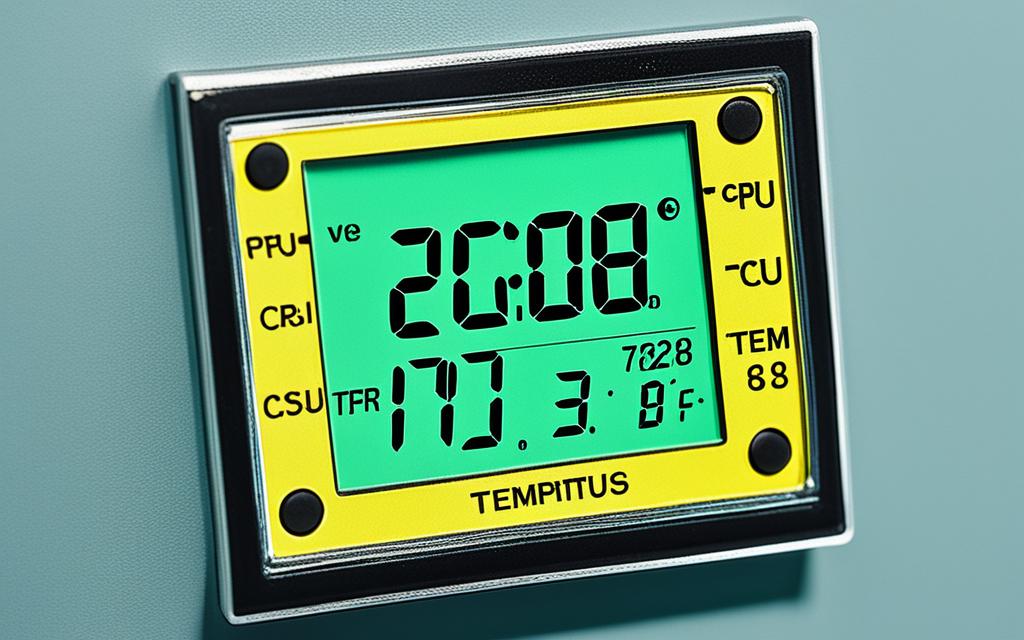Table of Contents
Knowing the right CPU temperature range is key to keeping your CPU performing well. CPUs can handle up to 100°C, but staying too hot for too long is bad. It can cause the CPU to slow down, work less efficiently, and even get damaged. A good CPU temperature is between 30°C to 40°C when not doing much. When the CPU is working hard, it can handle 70°C to 80°C. It’s important to check your CPU temperature often. Staying in the safe temperature range makes your computer last longer. For more info, click here1.
Key Takeaways
- A good temperature for desktop CPUs during idle is approximately 30°C to 40°C.
- Under load, desktops should ideally not exceed 70°C to 80°C.
- Laptop CPUs, especially slimmer models, may have different temperature expectations.
- Regular maintenance, such as cleaning and checking fans, can prevent overheating.
- Monitoring software like HWMonitor can effectively track your CPU’s thermal conditions.
Understanding CPU Temperature Ranges
It’s crucial to know about CPU temperature ranges. They help keep systems reliable and performing well. If you understand them, you can spot unusual heat levels that might mean a problem.
Normal Operating Temperatures
CPUs often run from 30°C (86°F) to 40°C (104°F) when not busy. Under regular use, temperatures can go up to 60°C to 70°C (140°F to 158°F). Modern CPUs can handle up to 80°C (176°F) when working hard2.
For gamers, CPU temperatures between 70°C (158°F) and 80°C (176°F) are typical. The highest safe temperature is usually 90°C (194°F)3. But, if temperatures constantly exceed 80°C (176°F), it’s time to check your system2.
How Load Affects Temperature
The load on a CPU greatly affects its temperature. High-demand apps can cause thermal throttling to keep things safe3. Different CPUs can tolerate different amounts of heat. For example, the Intel Core i5-12600K works well even at 100°C (212°F)3.
Keeping temperatures too high can speed up wear and tear and cause problems4. Always monitor temperatures. If they’re high even when the CPU isn’t doing much, you might need to fix your cooling system or clean out dust4.
| Usage Scenario | Idle Temperature | Normal Load Temperature | Heavy Load Temperature |
|---|---|---|---|
| Idle | 30°C – 40°C | ||
| Regular Use | 60°C – 70°C | ||
| Gaming/Heavy Tasks | 70°C – 80°C | Up to 90°C |
By learning about different temperature ranges, you can plan better for keeping your CPU cool234.
What Temperature Should CPU Be During Usage?
Knowing the safe CPU temperature ranges is key when you’re using your computer. It helps keep your computer running well for longer. It’s best to keep the CPU under 80°C (176°F). This keeps it working right without risk. CPUs do well between 70°C (158°F) and 85°C (185°F) during heavy use. But, going over 90°C (194°F) could cause big problems. High temperatures can slow down your computer or even damage it. That shows the risks of overheating CPUs56.
Safe Temperature Ranges
On a normal day, CPUs stay between 30°C (86°F) and 40°C (104°F). When working hard, like during gaming6, temperatures can reach 75°C (167°F) to 80°C (176°F). Keeping within these safe CPU temperature ranges helps your computer last longer. High temperatures can lower performance and make your computer less reliable. Using fans and CPU coolers helps keep things cool, especially when you’re doing a lot5.
Risks of High Temperatures
If your CPU gets above 80°C (176°F), it could get permanently damaged. Being too hot for too long can break important parts, causing crashes56. Overheating can make your CPU slow down to try to cool off. To avoid getting too hot, keep your computer clean and the air flowing well. Also, use good cooling devices5.
How to Check Your CPU Temperature
It’s important to keep an eye on your CPU temperature to keep your computer running smoothly. There are several ways to check the temperature, helping you to avoid overheating problems.
Using Built-in BIOS/UEFI
Checking the CPU temperature through the BIOS or UEFI of your computer is easy. You can see the temperature as soon as the computer starts. Just press F2, DEL, or ESC when you switch on your PC. This gives you an initial reading but it’s not updated in real time. To get ongoing updates, it’s best to use special software along with this method.
Third-Party Monitoring Tools
For constant temperature monitoring, software tools are a must. Apps like Core Temp, NZXT’s CAM, and HWINFO show up-to-date temperatures. They even track how the temperature changes when you use your computer more heavily. These apps help you spot temperature rises before they cause problems. Some tools also offer detailed records or instant warnings. Using these tools makes it easy to stay on top of your CPU temperature.
Find out more about monitoringyour CPU temperature and boost your computer’s health78.
Common Causes of High CPU Temperatures
Understanding what makes CPU temperatures rise is key to keeping your computer running well. Many things can cause CPU overheating, putting your system at risk. Dust build-up is one major problem.
Dust Accumulation
When your PC gets dusty inside, it can’t get rid of heat properly. Dust blocks fans and heatsinks, making your CPU work harder. This may cause your computer to slow down to avoid damage9. Cleaning your PC regularly keeps it cool and running smoothly10.
Inadequate Cooling Solutions
The right cooling system is vital to stop your CPU from getting too hot. If thermal paste gets old or isn’t put on right, it won’t work well. Many suggest switching to a liquid cooling system for better results9.
It’s also important to set up your computer’s fans correctly to keep air moving9. This keeps everything cooler and stops dust from gathering.
Overclocking Issues
Overclocking makes your CPU hotter as it works harder. You need good cooling to handle the extra heat. To keep things cool, you can lower your video settings, use energy-saving options, or even underclock9. Fixing software problems and clearing out malware are important too, as they can make your CPU run hot10.
Conclusion
Understanding your CPU’s temperature is crucial for its health and performance. It’s important to keep it cool. Gamers, note that during gaming, the temperature should be between 61 to 73 degrees Celsius. For everyday tasks, keeping it between 40 to 65 degrees Celsius avoids heat problems11.
When system load increases, temperatures can spike. Knowing when the temperature goes above 80 degrees Celsius is key. This helps prevent hardware issues11.
Using BIOS/UEFI settings and tools like Speedfan or HWMonitor helps you keep track of CPU heat. Adjusting fan speeds can cool down your CPU during heavy usage12. Regular clean-ups and efficient cooling are also vital. They significantly improve your CPU’s temperature and performance.
By focusing on these practices, you not only boost your CPU’s efficiency but also protect your system13. Monitoring CPU temperature carefully ensures smooth computer use. It lets you enjoy great performance and protect your investment.
FAQ
What is the optimal CPU temperature range for performance?
The best CPU temperature is usually between 30°C and 40°C when not doing much. When the CPU is working hard, temperatures can rise to between 70°C and 80°C. This keeps the CPU’s performance up.
How does CPU load affect temperature readings?
When the CPU is busy, like during gaming, temperatures can jump from 30°C-40°C to 70°C-85°C. Watching these changes helps keep the computer running smoothly.
What are the risks associated with high CPU temperatures?
If CPU temperatures go too high, it can cause several problems. These include throttling, hardware damage, and a shorter lifespan. It’s important to keep temperatures under 80°C to avoid issues.
How can I check the temperature of my CPU?
To see your CPU temperature, use the BIOS or UEFI when your computer starts. You can usually get there with keys like F2 or DEL. Tools like Core Temp or NZXT’s Cam also offer detailed temperature info.
What causes high CPU temperatures in my system?
High CPU temperatures can come from many sources. Dust can block fans and heat sinks, poor cooling systems might not lower heat well, and overclocking increases temperature. Keeping your system clean can help control heat.
How can I prevent my CPU from overheating?
Stopping your CPU from getting too hot means ensuring good airflow and keeping your computer clean. High-quality thermal paste and suitable coolers help too. Keep an eye on temperature levels for better CPU health and performance.
Source Links
- https://www.businessinsider.com/guides/tech/what-is-a-good-cpu-temp – What is a good CPU temperature? How to make sure your computer isn’t overheating, and how to cool it down
- https://www.noyafa.com/blogs/knowledge-base/good-cpu-temperature – What Is A Good CPU Temperature? A Guide to Keep Your Processor Cool
- https://community.spiceworks.com/t/what-is-a-normal-temperature-for-a-cpu-and-how-do-i-keep-it-low/948818 – What is a normal temperature for a CPU and how do I keep it low?
- https://www.avast.com/c-how-to-check-cpu-temperature – How to Check and Monitor Your CPU Temperature
- https://www.linkedin.com/advice/3/what-normal-optimal-ranges-cpu-temperature-different – What are the normal and optimal ranges of CPU temperature for different types of processors?
- https://www.shiksha.com/online-courses/articles/all-about-cpu-temperature-range/ – CPU Temperature Range That Must Be Maintained – Shiksha Online
- https://www.pandasecurity.com/en/mediacenter/how-to-check-cpu-temp/ – How to Check Your CPU Temperature – Panda Security
- https://www.tomshardware.com/how-to/how-to-check-cpu-temp-temperature – How to Check Your CPU Temperature
- https://www.linkedin.com/advice/1/how-can-you-lower-your-cpu-temperature-too-high – How can you lower your CPU temperature if it is too high or overheating?
- https://www.maketecheasier.com/troubleshoot-high-cpu-temperature/ – How to Cool Down a High CPU Temperature
- https://sciotovalleyguardian.com/2023/09/05/what-temperature-should-my-cpu-be/ – What Temperature Should My CPU Be? – Scioto Valley Guardian
- https://superuser.com/questions/1265417/reaching-nearly-80c-on-cpu-two-minutes-after-boot – Reaching nearly 80C on CPU two minutes after boot
- https://www.pugetsystems.com/labs/articles/impact-of-temperature-on-intel-cpu-performance-606/ – Impact of Temperature on Intel CPU Performance








